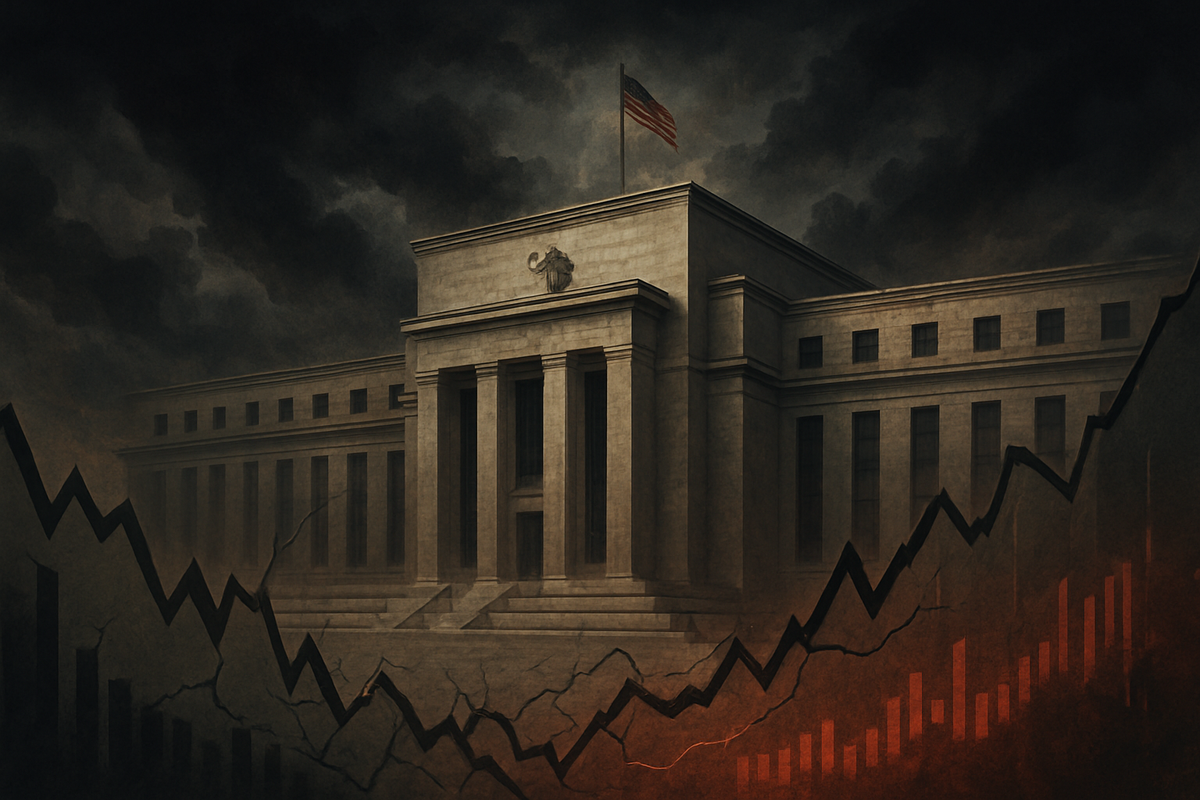
As of late 2025, global central banks find themselves in an increasingly precarious position, navigating the treacherous waters of persistent inflation and mounting political pressure. This convergence of economic and political forces is profoundly influencing monetary policy decisions, challenging the very independence of these institutions, and injecting significant uncertainty into financial markets worldwide. The delicate balancing act between taming elevated prices and fostering fragile economic growth is under intense scrutiny, with implications reverberating from Wall Street to Main Street.
The current landscape is defined by inflation stubbornly clinging above target levels in many major economies, even as some central banks begin to consider or implement interest rate cuts, often under direct political urging. This creates a volatile environment where policy divergence among central banks is becoming more pronounced, leading to heightened market sensitivity and a re-evaluation of traditional economic relationships.
The Unrelenting Squeeze: Inflation's Grip and Political Overreach
The inflationary environment continues to be a primary concern. In the United States, the annual Consumer Price Index (CPI) registered 3.0% in September 2025, while the Federal Reserve's (NYSE: FED) preferred Personal Consumption Expenditures (PCE) index showed an annual increase of 2.74% in August, both remaining above the Fed's 2% target. Similarly, the Eurozone saw annual inflation tick up to 2.2% in September, with core inflation at 2.3%, slightly exceeding the European Central Bank's (ECB) 2% goal. The United Kingdom continues its battle with high prices, with the CPI at 3.8% in September, nearly double the Bank of England's (BoE) 2% target. Japan's inflation accelerated to 2.9% in September, and Russia grapples with forecasts ranging from 6.5-7% by year-end.
This persistence is attributed to a cocktail of factors, including the lagged effects of new tariffs, increased energy consumption, robust services inflation, and the cumulative impact of significant money supply expansion since 2020. Trade protectionism, particularly new tariffs from the U.S., is a significant driver, projected to push U.S. inflation as high as 3.9% by year-end 2025, with some economists even forecasting a potential recession if tariffs remain steep. Strong wage growth in tight labor markets and ongoing supply chain disruptions further exacerbate price pressures.
Simultaneously, the bedrock of central bank independence is under severe threat. In the U.S., the Federal Reserve faces "unrelenting political pressure from the White House," with President Donald Trump explicitly demanding lower interest rates and making personal attacks on Fed Chair Jerome Powell. Initiatives like Project 2025 from the Heritage Foundation aim to subordinate the Fed to the executive branch, representing a direct assault on the traditional monetary policy model. Similar interventions have been observed in countries like Turkey and Russia, often leading to depreciating currencies and a loss of market confidence. This erosion of autonomy is a real-time risk, challenging central banks' ability to make decisions purely based on economic mandates.
These converging pressures have led to divergent monetary policy decisions globally. Despite persistent inflation, the Federal Reserve initiated a rate-cutting cycle in September 2025, reducing the federal funds rate by 25 basis points to 4.00%-4.25%, largely driven by a weakening labor market. Further cuts are widely anticipated. In contrast, the ECB maintained its main policy rate at 2% as of late 2025, while the Bank of England cut rates in August but holds them at 4% despite high inflation, facing pressure for further easing. The Bank of Canada (BoC) also cut its overnight interest rate in September, while the Bank of Japan (BoJ) might consider a rate hike given accelerating inflation. These varied approaches create a complex and often contradictory global monetary policy landscape.
Corporate Fortunes: Who Wins and Who Loses in a Shifting Landscape
The current economic milieu of persistent inflation, fluctuating interest rate expectations, and market volatility creates clear winners and losers across corporate sectors. Companies with strong fundamentals and strategic foresight are better positioned to navigate these headwinds.
Potential Winners:
- Companies with Strong Pricing Power: Businesses that can effectively pass on rising costs to consumers without significant demand destruction are clear beneficiaries. This often includes consumer staples (e.g., Procter & Gamble (NYSE: PG), Nestle (OTC: NSRGY)) and utilities (e.g., NextEra Energy (NYSE: NEE)), which provide essential goods and services.
- Energy Sector: Energy stocks tend to perform exceptionally well during inflationary periods as commodity prices rise. Companies like Devon Energy (NYSE: DVN), Occidental Petroleum (NYSE: OXY), and ConocoPhillips (NYSE: COP) are identified as potential beneficiaries.
- Financial Institutions (selectively): While rising rates generally boost net interest margins for banks, anticipated rate cuts could stimulate economic activity and lending volumes. Large commercial banks such as JPMorgan Chase & Co. (NYSE: JPM) and Bank of America Corp. (NYSE: BAC) could benefit from increased economic dynamism, though they must manage interest rate risk carefully.
- Technology and Growth Stocks (anticipating cuts): Many growth-oriented technology companies thrive on future earnings potential. Lower interest rates, by reducing discount rates, make these future cash flows more valuable. Companies like Apple (NASDAQ: AAPL), Microsoft (NASDAQ: MSFT), and NVIDIA (NASDAQ: NVDA) could see increased investor interest if rate cuts materialize.
- Companies with Strong Balance Sheets and Low Debt: Businesses not heavily reliant on borrowing are insulated from volatile interest expenses, making them more resilient during periods of uncertainty.
- Defense Contractors: Heightened geopolitical tensions, a contributor to market volatility, also drive increased government spending on national security, benefiting firms like Lockheed Martin (NYSE: LMT) and Raytheon Technologies (NYSE: RTX).
- AI-Related Investments: Business investment in artificial intelligence remains robust, fueling growth for companies involved in AI development and infrastructure.
Potential Losers:
- Highly Leveraged Companies: Businesses with substantial debt, particularly those with floating-rate loans or maturing fixed-rate debt needing refinancing, face significantly higher interest expenses. This can quickly erode profitability and cash flow, impacting sectors like highly capital-intensive industries or those that grew through debt-financed mergers.
- Consumer Discretionary Sector: As consumers grapple with higher borrowing costs and reduced purchasing power due to inflation, spending on non-essential goods and services declines. Retailers, hospitality firms, and automotive companies can be negatively impacted.
- Companies Reliant on Unstable Supply Chains or Exposed to Sanctioned Regions: Geopolitical conflicts and trade tensions severely impact companies with significant exposure to unstable supply chains or sanctioned countries. Russian energy giants like Rosneft (LSE: ROSN) and Lukoil (LSE: LUKOY) and major Russian banks have already seen considerable declines due to international sanctions.
- Businesses in Highly Competitive Markets with Limited Pricing Power: These companies may struggle to pass on rising input costs, leading to squeezed profit margins.
- Certain Growth Stocks (if rate cuts are delayed/insufficient): While anticipated cuts are a boon, if persistent inflation forces central banks to maintain a hawkish stance for longer, growth stocks with high valuations based on distant future earnings could suffer.
Broader Implications: A New Era of Economic Uncertainty
The confluence of persistent inflation and political pressure on central banks is not merely a short-term market fluctuation; it signifies a deeper shift in the global economic and political landscape, with far-reaching implications.
This environment fits into a broader trend of deglobalization and protectionism. The resurgence of trade protectionism, exemplified by new U.S. tariffs, is actively restructuring global supply chains. Companies are increasingly looking to "reshore" or "friendshore" production to mitigate tariff risks and enhance resilience, moving away from purely efficiency-driven models. This has ripple effects, potentially leading to higher costs for consumers and businesses reliant on imported goods, while creating opportunities for domestic industries.
A significant regulatory and policy implication is the erosion of central bank independence. This fundamental principle, crucial for maintaining price stability, is under threat globally. The U.S. Federal Reserve, a beacon of independence, faces direct challenges, and populist movements worldwide increasingly target central banks. If central banks are perceived as losing their grip on inflation due to political interference, inflation expectations could become de-anchored, making future price stability much harder to achieve. The International Monetary Fund (IMF) has stressed the importance of central bank independence, particularly for Asian economies, to anchor inflation expectations and avoid capital outflows.
Historically, this period draws stark comparisons to the high-inflation era of the 1970s. That decade also saw rampant inflation, fueled by supply shocks (like oil price surges) and political pressure on central banks to prioritize employment over price stability. This led to insufficient monetary tightening, allowing inflation to become entrenched and resulting in "stagflation" – a period of high inflation and stagnant economic growth. The lesson learned, and now being re-examined, is that failing to react sufficiently to inflation does not yield economic gains and can severely undermine central bank credibility. President Richard Nixon's influence over the Fed in the 1970s, which "fuelled the raging inflation," serves as a potent cautionary tale against political meddling.
Potential ripple effects include heightened market volatility as investors navigate mixed signals and data-dependent central bank decisions. Stagflation risk remains a tangible concern if persistent supply-side cost pressures continue to fuel inflation while demand moderates. Furthermore, political interference in the Fed could shake trust in the U.S. dollar, potentially leading to its depreciation and impacting global financial markets, driving central banks to diversify reserves, notably into gold. This "debasement trade" is expected to continue, providing a structural floor under gold prices.
The Road Ahead: Navigating Uncertainty and Adapting Strategies
Looking ahead, the global economic landscape in late 2025 and into 2026 promises continued complexity and a dynamic interplay of forces.
In the short-term, central banks will likely continue their delicate dance of interest rate adjustments. The Federal Reserve is widely expected to implement further rate cuts in late 2025 and early 2026, balancing persistent inflation with a softening labor market. The ECB and BoE are also likely to proceed cautiously with potential further easing, while the Bank of Japan might contemplate a rate hike. This divergence in policy will continue to drive currency market volatility and capital flow shifts. Market stability will remain fragile, with equity markets showing resilience driven by AI enthusiasm but vulnerable to growth disappointments or unexpected hawkish shifts from central banks.
The long-term outlook suggests an evolution of central bank mandates, potentially towards a more active role in managing government balance sheets due to high public debt and political pressures. Preserving central bank independence against political interference will be paramount to avoid spiraling inflation and loss of credibility. Global growth is projected to remain moderate, with the IMF's five-year forecast at its lowest in decades, reflecting ongoing challenges like trade barriers, aging populations, and low productivity growth. A "stagflationary" environment remains a pessimistic but plausible scenario.
Potential strategic pivots are required across the board. For central banks, this means maintaining a data-dependent and flexible policy stance, preserving independence, and refining policy tools, possibly including sector-specific interventions. Businesses must prioritize supply chain diversification and resilience, embrace technological advancements like AI to boost productivity, and maintain strong financial discipline to navigate higher capital costs. Investors should focus on portfolio diversification across regions and asset classes, incorporate inflation-hedging strategies, and remain highly vigilant to economic data and central bank communications. Governments, in turn, must pursue fiscal consolidation, implement structural reforms, and uphold central bank independence.
Market opportunities may emerge in sectors benefiting from AI and digital transformation, resilient supply chains, and green growth initiatives. Emerging markets also offer untapped growth potential. However, significant challenges include persistent inflation, the ongoing threat to central bank independence, escalating geopolitical risks and trade protectionism, and high public debt. The key scenarios ranged from a "soft landing" (base case) where inflation gradually declines without a severe recession, to a "hard landing" or outright recession, and a potential "stagflation" scenario. An "AI supercharge" represents an optimistic long-term outcome, but its full impact and risks are yet to be fully understood.
Wrap-Up: A Test of Resilience and Adaptability
In summary, the global financial markets are at a critical juncture, defined by the interplay of persistent inflation and unprecedented political pressure on central banks. Key takeaways include the fragility of central bank independence, the complex and often divergent monetary policy responses globally, and the profound impact on corporate profitability and market stability.
Moving forward, the market will continue to be highly sensitive to inflation figures, employment reports, central bank communications, and geopolitical developments. Investors should watch for signs of inflation expectations becoming de-anchored, further political interventions in monetary policy, and the trajectory of global trade relations. The resilience of corporate earnings, particularly outside the AI mega-caps, and the ability of central banks to navigate this challenging environment without sacrificing their credibility will be crucial determinants of market performance. This era demands a high degree of adaptability, strategic foresight, and a nuanced understanding of intertwined economic and political forces.
This content is intended for informational purposes only and is not financial advice





